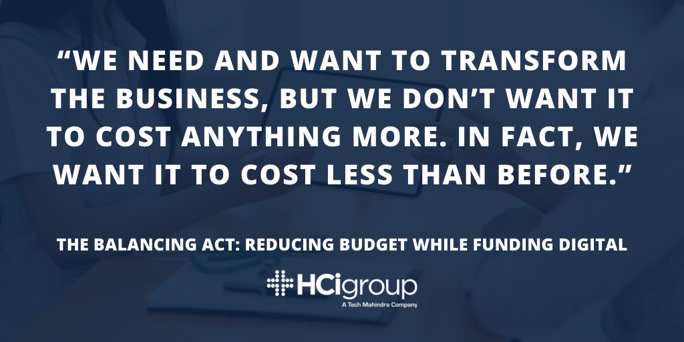The Balancing Act: Reducing Budget While Funding Digital


At a recent CHIME fall focus group, Ed Marx, Will Conaway & Vikram Singh of The HCI Group & Tech Mahindra had the opportunity to ask key questions around the topic of reducing budgets while funding digital to some of the leading CIOs in the country. As well as getting to directly ask CIOs what leadership challenges they were facing in trying to balance reduced budgets with increased growth, The HCI Group also presented their model for reducing expenditure to free up budget for distribution in more strategically relevant areas of the organization.
The Balancing Act Conundrum
“We need and want to transform the business, but we don’t want it to cost anything more. In fact, we want it to cost less than before.”
Many CIOs are dealing with some variation on the expectation that they should be decreasing and removing costs, WHILST simultaneously increasing satisfaction with IT services AND investing in digital transformation for their organizations. Whilst some may have the luxury of being allowed a couple of years runway to achieve the digital transformation growth, many CIOs will agree that their organizations have not gifted them with that leeway, and they are required to implement these three key things all at the same time in a very short timeframe.
What other complexities are CIOs trying to balance?
On top of the conundrum listed above, other complexities and tasks that CIOs note they are challenged to balance alongside other major strategies include the enhancements of cyber environments & improvement of virtual health, managing remote working, data security, IoT (internet of things), combating cloud-based threats and getting staff and patients to engage and adopt new technology.
When asked how CIOs were leading through the conundrum, the focus group noted that communication and transparency were key, as well as understanding capabilities, difficulties and the needs of their teams. Furthermore, building relationships and engaging staff were also noted as key factors to good leadership through these turbulent times. The recruitment and retention of staff is an obstacle for many during this time of transformation. Managing the fast-paced injection of new digital tools within an organization can be difficult if the time is not taken to find the right talent to implement digital change and engage them with your digital strategy.
The main obstacle CIOs are facing?
Identifying priorities and assigning budgets and funding accordingly based on a strategy of what has the most longevity and relevance post-COVID is a main obstacle for many CIOs. As such, The HCI Group shared their model for reducing expenditures through short-term assessments and specific projects focused on eliminating waste in your spend on IT infrastructure, as well as more long term thinking strategies.

Project Specific Model for Reducing Costs – Quick Wins
This proven model looks at common areas where spending is allocated that will often be costing double when not needed. Here are the three areas we suggest our CIOs look to make significant savings:
Hardware maintenance optimization – 5-20% savings
Optimize hardware maintenance based on desired SLA and architecture (e.g. if a site has redundancy with dual circuits terminating on dual routers, and organization may be able to use 8x5xNBD maintenance as opposed to 24x7x4 maintenance). Optimize cost as opposed to paying for expensive maintenance options.
License optimization for IT applications – 5-10% savings
Look to model usage profiles more effectively by determining the optimal mix of licenses based on licensing packages offered by the OEM (e.g. number of “fulfiller” licenses as opposed to “requestor” licenses in the case of Service Now. A fulfiller licence will cost up to 3x more.) Looking to optimize these licences can give you significant savings towards to your current spend.
Consumption monitoring & optimization – 5-10% savings
Scale down idle capacity for dynamically scalable services (e.g. AWS services, dynamic ports) and building ongoing discipline to monitor and manage.
MSP Model for Reducing Costs – Long Term Thinking
Identifying long-term significant savings opportunities and understanding the potential process impacts for various stakeholders can lead to significant savings for CIOs. Whilst outsourcing might not always be the ideal solution for some, bringing in a firm that has experience of delivering effective IT operations can provide organizations with the additional skillset they require to produce the potential savings listed below.
Application Development & Maintenance – 20-50% savings
- Develop portfolio inventory, current support models, performance metrics
- Provide Hybrid application MSP services
- Explore Application rationalizing for further cost reduction
Data Centre & Compute Services – 15-35% savings
- Provide data center services (rack space, power, cooling)
- Develop and implement virtualization strategy (reduce costs, improve support performance); provide server and storage support services; implement storage tiering (e.g. EMR data vs image archiving)
Application Hosting – 5-30% savings
- Identify candidate applications for hosting (e.g. EHR) and associated requirements
- Migrate applications to new environment
Managed Infrastructure & Security Services – 25-40% savings
- Develop Infra & Security requirements (network, data center, end user, partners, customers/patients, HIPAA, PCI, etc.)
- Provide managed infra & security services through a hybrid model
Telecom Architecture & Sourcing – 5-30% savings
- Consolidate WAB services, ensuring capacity and QoS sufficient for key traffic (e.g. imaging, unified communications, telemedicine)
- LAN and WLAN refresh to improve coverage and reduce downtime
Help Desk – 20-30% savings
- Rationalize clinical and IT help desks; provide hybrid model aimed at better end user experience
- Use shift left techniques for improving AHT
To find out how we partner with $2 billion health system in the southwest to digitally transform and reduce expenses download our TCO case study:

